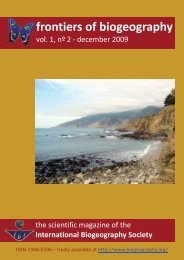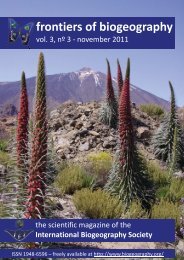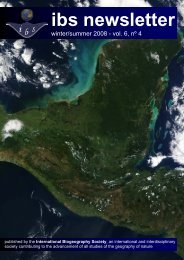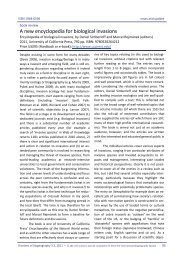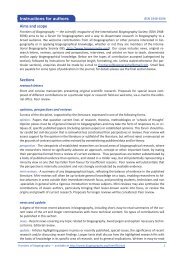1 - The International Biogeography Society
1 - The International Biogeography Society
1 - The International Biogeography Society
- No tags were found...
You also want an ePaper? Increase the reach of your titles
YUMPU automatically turns print PDFs into web optimized ePapers that Google loves.
news and updateFigure 1. Studies of biogeography and ecology converge atintermediate spatial and temporal scales typical of themetapopulation (mp), metacommunity (mc) and regionalcommunity (rc), following Jenkins and Ricklefs (2011b).Other symbols represent the individual organism (i), population(p), assemblage (a), species’ range/s (sr), and biota(b). Positioning in relation to the space and time axes isintended to represent approximate scale, while acknowledgingthere may be considerable spatial and temporalvariation within and between places, times, and also amongtaxa. Examples of two hypothetical taxa (black text in theforeground and white in the background, representing avery simple system with respect to the taxon axis) are providedto illustrate that ecological and biogeographic processeslikely have spatio-temporal relationships that varywith species’ traits and biophysical interactions that do notscale linearly with organism size (e.g. Dawson & Hamner2008 [figure 6]). Identifying natural boundaries amongthese scales, or the extent to which scales overlap, is a challengingresearch agenda that may be enabled by coordinatedteams of biogeographers and ecologists (Chiarucci etal. 2011) working across scales, using new metrics such asphylobetadiversity (Emerson et al. 2011). <strong>The</strong>se are fundamentalchallenges in how we represent, and therefore howwe think about (and vice versa), the world.of biogeography and ecology (Ricklefs and Jenkins2011) can continue may similarly depend uponthe approach. Recent efforts to develop unifiedtheory are a little younger than macroecology(Hubbell 1997, 2001, Vellend 2005, Rosindell andPhillimore 2011) and more strongly contested(e.g. Roughgarden 2009, Fukami 2010, Clark2012), perhaps in part because of the long historyof thought surrounding idiosyncrasies in biology(Gould 1989, McIntyre 1997, Lawton 1999). Yetthe truism that each extant species has an uniquehistory of lineage and place (Lomolino et al. 2006)should not overwhelm the evidence from manynatural examples of evolutionary convergences(Norris 1991, Van Valkenburgh 2007) and parallels(Elmer and Meyer 2011, Smith and Lyons 2011,Dawson 2012), nor from general theory (e.g. Mac-Arthur and Wilson 1967) and ‘rules’ (e.g. Lomolinoet al. 2006), that suggest natural laws (Ghiselin1994). By broadening the scales across whichsome natural phenomena traditionally have beenstudied (see Rosindell et al. 2011) we may encompassindividualism and unity within a single framework,thus avoiding the extremes of übercontingencyor naturalistic theism (Gould 1989,Morris 2005), and maintaining an healthy tensionthat lends itself to inquisition via the logical treeof strong inference (Platt 1964). <strong>The</strong> perspectivesprovided by comparative biogeography and macroecology,for example, escape the overwhelminglycomplicated contingency at the intermediatescales studied by community ecology (Lawton1999).Striking a balance between empiricism andtheory also is essential. Sixty-two years ago, AlbertEinstein published his conception for general unifiedfield theory (Einstein 1950), which at the timewas largely ignored but now coalesces mainstreamresearch in fundamental physics. Einsteinbelieved that extrapolation from phenomenologicalstudy depended too much on concepts veryclose to the measured experience (Van Dongen2010:63). In biogeography and ecology, the scalesat which the heterogeneity in interactions betweenorganisms and environment manifest—andestimates of α-, β-, and γ-diversity—are affectedby the grain, focus, and extent by which a particularassemblage is measured (Chiarucci et al. 2011).Because of this epistemological constraint, Einsteinbelieved that physics needed to “apply freespeculation to a much greater extent” (Van Dongen2010:93).4 © 2012 the authors; journal compilation © 2012 <strong>The</strong> <strong>International</strong> <strong>Biogeography</strong> <strong>Society</strong> — frontiers of biogeography 4.1, 2012






